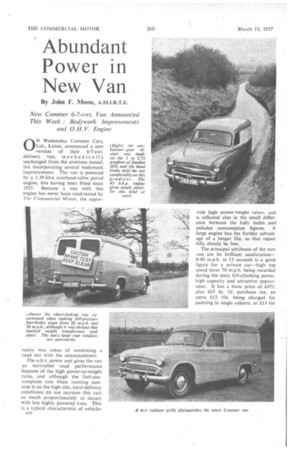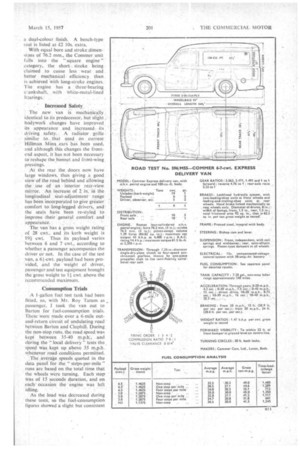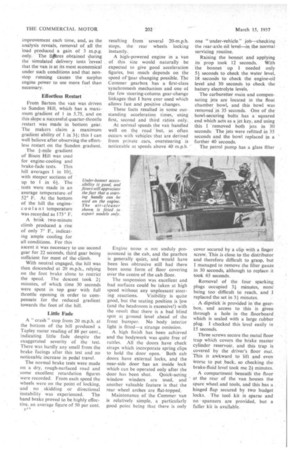Abundant Power in New Van
Page 44

Page 45

Page 46

If you've noticed an error in this article please click here to report it so we can fix it.
By John F. Moon, A.M.I.R.T.E.
New Commer 6-7-cwt. Van Announced This Week : Bodywork Improvements and O.H.V. Engine
0 N Wednesday Commer Cars, Ltd., Luton, announced a new version of their 6-7-cwt. delivery._ van, mechanically unchanged from the previous model, but incorporating several bodywork improvements. The van is powered by a 1.39-litre overhead-valve petrol engine, this having been fitted since 1955. Because a van with this engine has never been road-tested by The Commercial Motor, the oppor
tunity was taken of combining a road test with the announcement.
The o.h.v. power unit gives the van an unrivalled road performance because of the high power-to-weight ratio, and although the fuel-consumption rate when running nonstop is on the high side, local-delivery conditions do not increase this rate so much proportionately as occurs with less highly powered vans. This is a typical characteristic of vehicles al 0
with high power-weight ratios, and is reflected also in the small difference between the fully laden and unladen consumption figures. A large engine has the further advantage of a longer life, so that repair bills should be low.
The principal attributes of the new van are its brilliant acceleration0-40 m.p.h. in 13 seconds is a good figure for a private car—high top speed (over 70 m.p.h. being recorded during the test), hill-climbing power. high capacity and attractive appearance. It has a basic price of £475, plus £63 8s. 5d. purchase tax, an• extra £12 10s. being charged for painting in single colours, or £15 for . a dual-colour finish. A bench-type seat is listed at £2 10s. extra.
With equal bore and stroke dimen• siorts of 76.2 mm., the Commer unit rails into the "square engine " category, the short stroke being claimed to cause less . wear and better mechanical efficiency than. is achieved with long-stroke engines. The engine has a three-bearing c -an k shaft; with White-metal-lined barings..
_ • Increased Safety_
• The new van is mechanically identical to its predecessor, but slight bodywork changes have improved its appearance and increased, -its . driving safety. A radiator grille similar to that used on current Hillman Minx cars has been used, and although this changes the frontend aspect, it has not been necessary to reshape the bonnet and front-wing pressings.
At the rear the doors now have large windows, thus giving .a good view of the road behind and allowing the use of an interior rear-view mirror. An increase of 2 in. in the longitudinal s'eat-adiustment range has been incorporated to give greater comfort to Tong-legged drivers, andthe seats have been re-styled to improve -their general comfort and
appearance. . ' • •
The van has a gross weight rating. of 28 cwt., and its kerb weight is 101: cwt. Thus its payload varies between 6 and 7 cwt., according to whether a passenger accompanies the driver or not. In the case of the test van, a 6+-cwt. payload had been provided, and the weight of driver, passenger and test equipment brought the gross weight to 11 cwt. above the recommended maximum.
Consumption Trials .A 1-gallon fuel test tank had been fitted, so, with Mr. Roy Tatum as _ passenger, I took the van out to Barton for fuel-consumption trials. These were made over a 6-mile out. and-return circuit of undulating road between Barton and Cloph ill. During the non-stop runs, the road speed was kepi between 35-40 M.p.h.:, and during the "local delivery " tests the . speed was kept up above 35 rn...p.h. whenever road conditions permitted.
The average speeds quoted in the data panel, for the " stops-per-mile " runs are based on the total time that the Wheels were turning. Each stopwas of 15 seconds duration, and on each occasion the engine was left
As the load was dedreased during these tests., so the fuel-consumption figures showed a slight but consistent
improvement each time, and, as the analysis reveals, removal of all the load produced a gain of 3 m.p.g. only. The fibres obtained during the simulated delivery tests reveal that the van is at its most economical under such conditions and that nonstop running Causes the surplus engine power to use more fuel than necessary.
Effortless Restart From Barton the van was driven to Sundon Hill, which has a maximum gradient of I in 5.75, and on this slope a successful quarter-throttle restart was made in bottom gear. The makers claim „a. maximum gradient ability of 1 in 31; this I can well believe after observing the effortless restart on the Sundon gradient. The f mile gradient of Bison Hill was used for engine-cooling and brake-fade tests. This hill averages 1 in 104, with steeper sections of up to 1 in 61. The tests were made in an average temperature .of 52° F. At the bottom of the hill the engine-coolant temperature was recorded as 173' F.
A brisk two-minute climb produced a rise of only 7° F., indicating ample cooling for all conditions. For this ascent it was necessary to use second gear for 22 seconds, third gear being sufficient for most of the climb.
With neutral engaged, the hill was then descended at 20 m.p.h., relying on the foot brake alone to restrict the speed. The descent took 21 minutes, of which time 30 seconds were spent in top gear with full throttle opening in order to compensate for the reduced gradient towards the foot of . the hill.
Under-bonnet accessibility is good, and fitters will appreciate the fact that a starting handle can be used on the engine. The air-cleaner shown is fitted. to export models only.
Little Fade A " crash " stop from 20 m.p.h. at the bottom of the hill produced a Tapley meter reading of 88 per cent., indicating little fade despite the exaggerated severity of the test. There was hardly any smell from the brake facings after this test and no noticeable increase in pedal travel.
The normal brake tests were made on a dry, rough-surfaced road and some excellent retardation figures were recorded. From each speed the wheels were on the point of locking, and no skidding or directional instability was experienced. The hand brake proved to be highly effective. an average figure of 50 per cent.
p.1
resulting from several 20-m.p.h. stops, the rear wheels locking instantly.
A high-powered engine in a van of this size would naturally be expected to give good acceleration figures, but much depends on the speed of -gear changing possible. The Commer gearbox has a first-class "synchromesh mechanism and one of the few steering-column gear-change linkages that I have ever used which allows fast and positive changes.
These facts resulted in some outstanding acceleration times, • using first, second and third ratios only.
At normal speeds the van handled well on the road hut, as often occurs with vehicles that are derived from private cars, oversteering is noticeable at speeds above 40 m.p.h. • Engine noise is not unduly pronounced in the cab, and the gearbox is generally quiet, and would have been less obtrusive still had there been some form of floor covering over the centre of the cab floor.
The suspension was excellent and bad surfaces could be taken at high speed without any unpleasant steer ing reactions. Visibility is quite good, but the seating position is low (and the headroom is excessive!) with the result that there is a bad blind spot at ground level ahead of the front bumper. No body interior light is fitted—a strange omission.
A high finish has been achieved and the bodywork was quite free of rattles. All the doors have check straps which incorporate spring clips to hold the door open. Both cab doors have external locks, and the near-side door has an inside lock which can be operated only after the door has been shut. Quick-acting window winders are used, and another valuable feature is that the rear wheel arches are flat-topped.
Maintenance of the Commer van is relatively simple, a particularly good point being that there is only one " under-vehicle " job—checking the rear-axle oil level—in the normal servicing routine.
Raising the bonnet and applying its prop took 12 seconds. With the bonnet up 1 needed only 51 seconds to check the water level, 18 seconds to check the engine-oil level. and 30 seconds to check the battery electrolyte levels.
The carburetter main and compensating jets are located in the float chamber bowl, and this bowl was removed in 35 seconds. One of the bowl-securing bolts has a squared end which acts as a jet key, and using this I 'removed both jets in 30 seconds. The jets were refitted in 35 seconds and the bowl replaced in a further 40 seconds.
The petrol pump has a glass filter
cover secured by a clip with a finger screw. This is close to the distributor and therefore difficult to grasp, but I managed to remove the filter gauze in 30 seconds, although to replace it took 65 seconds.
Removal of the four sparking plugs occupied 31 minutes, none being too difficult to reach, and I replaced the set in 31 minutes.
. A dipstick is provided in the gearbox, and access to this is given through a hole in the floorboard which is sealed with a large rubber plug. I checked this level easily in 15 seconds.
Three screws secure the metal floor trap which covers the brake master cylinder reservoir, and this trap is covered by the driver's floor mat. This is awkward to lift and even worse to put .back, so checking the brake-fluid level took me 2+ minutes.
A compartment beneath the floor at the rear of the van houses the spare wheel and tools, and this has a hinged flap secured by two budget locks. The tool kit is sparse and no spanners are provided, but a fuller kit is available.




































































































